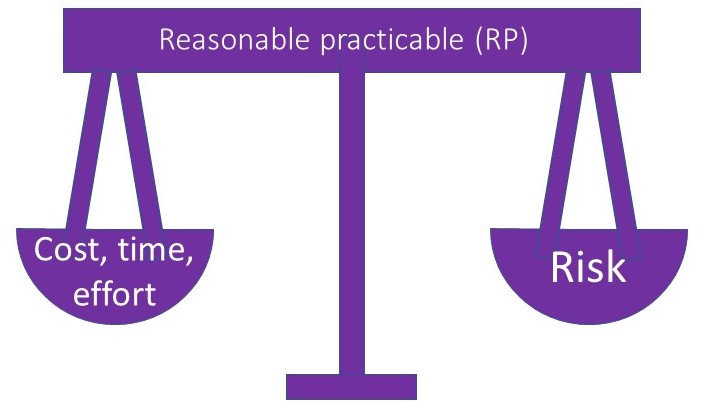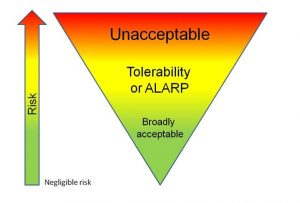What is: reasonably practicable?
First published in Health and Safety at Work Magazine, January 2013
Bridget Leathley continues her exploration of the foundation concepts of safety management by unpicking the many interpretations of the term ‘reasonably practicable’
You might also find my shorter lexicon article, A is for ALARP, of interest.
The concept of “reasonably practicable” lies at the heart of the British health and safety system. For four decades, it has formed a key part of the general duties under the Health and Safety at Work Act and many sets of supporting regulations.
Under Sections 2 and 3 of the Act, for example, employers (and under Section 3, the self-employed) must ensure the health and safety of employees and others “so far as is reasonably practicable” (SFAIRP)
In his 2011 review Reclaiming health and safety for all, Professor Ragnar Löfstedt noted that respondents had “overwhelmingly” supported the SFAIRP qualification in much of health and safety legislation because it allows risks to be managed in a proportionate way. He added, however, that there is “general confusion” over its meaning in practice.
He recommended that the HSE should “continue to help businesses understand” what is “reasonably practicable” for specific activities where the evidence demonstrates that they need further advice to comply with the law in a proportionate way.
In the health and safety context, the term “reasonably practicable” is much older than the 1974 Health and Safety at Work Act. The HSE website quotes the definition from the 1949 Court of Appeal judgment in Edwards v National Coal Board: “‘Reasonably practicable’ is a narrower term than ‘physically possible’ … a computation must be made by the owner in which the quantum of risk is placed on one scale and the sacrifice involved in the measures necessary for averting the risk (whether in money, time or trouble) is placed on the other, and that, if it be shown that there is a gross disproportion between them – the risk being insignificant in relation to the sacrifice – the defendants discharge the onus on them.”
This suggests that the only weights to be placed on the scales opposite risk are those of money, time and trouble (or effort). In this article, we suggest additions to this list and discuss how lack of money or time may (and may not) be used to defend a decision not to counter a risk.

“Reasonably practicable is a narrower term than physically possible and and seems to me to imply that a computation must be made by the owner in which the quantum of risk is placed on one scale and the sacrifice involved in the measures necessary for averting the risk (whether in money, time or trouble) is placed in the other, and that, if it be shown that there is a gross disproportion between them – the risk being insignificant in relation to the sacrifice – the defendants discharge the onus on them.”
Edwards v. National Coal Board (1949)
Money, time and trouble
The money, time and trouble argument does not work for an individual employee. If an organisation has a safe system of work requiring employees to wear personal protective equipment (PPE) to carry out a task, the employee cannot use as an excuse that it was too much trouble to locate and don the PPE. This much is well understood.
What is less well considered is how the money, time and trouble argument applies at an organisational level. A well-run and profitable chain of climbing centres follows the manufacturers’ guidance by sending a competent person to inspect all harnesses every six months, replaces all equipment after five years, and gives instructors regular toolbox talks on pre-use inspections. This is all documented and auditable.
The manager of a small climbing centre argues that if it did the same, the business would not be profitable. Instead, it opts for before-use inspections by the instructors using their experience and replacing equipment when they think it should be replaced. The manager might try to argue it is not reasonably practicable to do otherwise, since the costs of meeting the manufacturer’s guidance would put his firm out of business. He cannot use this argument if the company has not met a minimum standard of safety.
Roger Bibbings, of the Royal Society for the Prevention of Accidents, says: “The affordability of specific measures does not relate to the financial status of the individual dutyholder but is a broad social judgement – looking at what might be generally affordable, say across a sector. You cannot plead poverty and get away with a lower standard of safety.”
The HSE confirms: “Individual dutyholders’ ability to afford a control measure or the financial viability of a particular project is not a legitimate factor in the assessment of its costs.

However, that does not mean that the financial position of the dutyholder would never be considered. “While a national supermarket chain can afford to spend money on the latest engineering controls for docking bays, a small retailer may never have those resources at the levels necessary to be able to afford to purchase and maintain such sophistication,” explains Duncan Spencer, health and safety manager for Waitrose. “Just because some organisations can afford the latest means of reducing risk doesn’t make that control reasonably practicable for everyone else.”
There is support for this position in HSE advice to its own inspectors, under the heading Fallacy 2: “Some organisations implement standards of risk control that are more stringent than good practice … It does not follow that these risk control standards are reasonably practicable … and you should not seek to enforce them.”
Boundary change
Perhaps the key to understanding where organisations can use the time, money and trouble argument is to remind ourselves of the ALARP triangle. There are numerous variations of this on the HSE website and elsewhere, some with numbers, some without.
Within the unacceptable (sometimes labelled “intolerable”) area, no individual, organisation or industry can argue they do not have enough money to make something safer. It must be made safer, or not done at all.
Within the tolerability region, the onus is on the dutyholder (usually the employer) to demonstrate that risks are ALARP and that to spend any more money would be disproportionate to the risks involved.

Within the broadly acceptable region, it’s tempting to think we need do nothing. But though “negligible risk” is shown at the bottom of the risk axis, the HSE still requires firms to demonstrate they are following legislation and managing risk. Risk assessments must be carried out, fire precautions put in place and welfare facilities provided.
Although the HSE might find a “broadly acceptable” region useful for regulation, for most organisations the distinction between the ALARP triangle’s yellow and green region is artificial, and possibly unhelpful.
It is more straightforward, therefore, to consider only a single threshold. Some risks are intolerable and must be eliminated or reduced at any cost; below the intolerable level, the reasonably practicable argument can be used, provided all the essentials are in place. But how does the person in charge of health and safety spending know when the risk is tolerable, where they can consider costs and benefits; and when it is in the intolerable region, where they can’t?
Note that the ALARP triangle has no firm boundaries between the regions. The boundaries change. New technology may make the control of a hazard so much cheaper that previously tolerable risks become intolerable – rented domestic accommodation is expected to have smoke detection, not because the risk of house fires has ever gone up, but because the cost of buying and fitting smoke detectors has gone down.
Social changes may also bring about changes in tolerability – children no longer clean textile debris out of moving machinery to keep the British Empire afloat. And a single accident such as the 2011 Fukushima Daiichi nuclear disaster in Japan – can change tolerability for a specific hazard
Deciding tolerability
The public does not respond to risks in a proportionate manner. Hazards with a dread factor, such as nuclear or biological ones, are tolerated less than those resulting in slips and trips or back pain; the public tends to worry more about the severity of an accident and the number of people killed than the likelihood or frequency.
Thirty-one people killed in a train crash on one day is a tragedy that echoes through the decades; that more than this number of people are killed on UK roads every week in separate road accidents has become commonplace. Risks are generally more tolerable where we feel we have control over them. Many people, for example, prefer the higher likelihood of an accident when driving compared with flying because, on an aircraft, someone else is in control.
We might therefore expect a regulator to be scientifically objective – to demand that those hazards with the greatest mathematical risk are controlled over and above those with a lower risk, regardless of perception.
Let us accept nuclear power, genetically modified organisms and strangers talking to our children as they walk to school, and instead deal with road safety, lack of exercise and broken families.
The 2001 publication Reducing risks, protecting people (R2P2) outlines the HSE’s decision-making approach, and makes it clear that the regulator – while trying to be transparent, proportionate and accountable – does not look only at absolute risks to decide on tolerability or reasonable practicability. The document refers to the importance of “taking into account other factors such as ethical, economic and social considerations” and even “the preference values of society at large”.
Ethical and social considerations and preference values make it harder for a dutyholder to assess whether they are doing enough.
R2P2 defines tolerability as “the willingness to live with a risk so as to secure certain benefits”, implying a much more complicated balancing act than simply considering money, time and trouble. During the BSE (bovine spongiform encephalopathy) scare in the 1990s, many people avoided buying beef – until quality cuts of beef were cheaper than baked beans, at which point the willingness of people to live with the risk of BSE increased.
Bibbings’ experience is that the HSE may shift its expectations based on the resources a company has. “In practice,” he notes, “the HSE [is] likely to allow a cash-strapped business time to catch up with compliance on the lower-risk issues if they are making efforts to address priority risks.”
At a time when many businesses are struggling within an economy in recession, will regulators lower the bar across the board? Accepting non-compliance on the low-risk issues may not have a great impact in the short term, but raising the tolerability bar could have much more serious consequences.
2021 addendum, in relation to COVID-19 and Grenfell
When I wrote this article no one would have thought it would be considered ‘reasonably practicable’ to expect people to wear face coverings on public transport and in shops or to require people to wash or sanitise their hands several times a day? It would have been difficult to imagine any situation where shutting schools, shops, workplace became the best ‘reasonably practicable’ control measure. What is reasonably practicable changes with the circumstances – something we need to consider when reviewing our risk assessments.
In relation to ‘regulators lowering the bar’ it seems that might have been a key underlying cause of the Grenfell disaster, and of the difficulties still faced by many high-rise dwellers all of the country. Perhaps COVID-19 will raise the bar again, but hopefully in the right way.
Bridget Leathley
The original quote from the National Coal Board case includes the term “gross disproportion”. A management-driven cost-benefit study would attempt to reduce all costs to a single unit of measurement – normally £ – and simply find the most cost-effective option. But in considering what is reasonably practicable, health and safety factors weigh more heavily than financial costs.
The HSE puts this in mathematical terms, defining the disproportion factor (DF) as the costs divided by the benefits. The DF should never be less than one, and will be higher where the initial risk is higher. The HSE provides suggested values for DF of up to three for workers and up to 10 for members of the public.
Though many organisations will never calculate the DF, this does indicate the likely harsher judgment on an organisation if it uses a reasonably practicable defence when a member of the public has been killed.
Beauty versus truth
In practice, does the consideration of reasonably practicable really only involve time, effort and money? Andy Stokes, head of safety management at the conservation organisation RSPB, believes there is more to it – where the purpose of an activity is enjoyment, controls that reduce that enjoyment may not be practicable. “It could be argued that it would be a relatively low cost in time, money and trouble for the RSPB and others to run a fence along a cliff top, thereby protecting the public from the known risk of falls from height,” he says. “However, we have to evaluate risk and controls in the context of the benefits that visitors are expecting to gain when they visit us. The HSE understands and endorses this approach to risk management.”
The Visitor Safety in the Countryside Group (VSCG) (since renamed Visitor Safety Group) brings together organisations such as the RSPB and National Trust to share experiences of balancing visitor safety with visitor benefits. In a judgment, the judge dismissed the case made by an injured skier that the resort management should have labelled any dangerous features. Warning signs may have been cheap to put in place, but the judge recognised that placing warning signs at regular intervals along the summit ridge would be a disproportionate response to the risk, given the “natural beauty and attractiveness of the wilderness site”. Could an organisation, therefore, weigh beauty and attractiveness against health and safety in a reasonably practicable argument? Perhaps one for the philosophers and poets to argue with the lawyers about.
If beauty is a factor in calculating gross disproportion, does this apply only to the leisure industry, or can such wider principles apply elsewhere? Do the unquantifiable benefits of having a fleet of professionally branded vehicles driving along the motorways outweigh the greater risks compared with rail freight? Do we cherish our unguarded railway platforms, complete with quaint GWR seating and flower pots, as part of our British railway heritage so much we could not bear to see platform edge protection?-
So what is it?
Considering all the arguments, what do you have to do to show you have acted to reduce risk SFAIRP? The baseline requirement is to follow all legal requirements, and to apply existing best practice unless you can make a clear argument for doing otherwise. Best practice will include HSE Approved Codes of Practice; British, European and international standards; and guidance issued by employer groups and industry bodies.
Regardless of the maths, you will be expected to do more where many people could be harmed in a single event than the same number of people over a longer period, particularly if those people are members of the public, and even more so if they are seen as vulnerable. The term “gross disproportion” rules out a simple cost-benefit analysis; the default is that you must adopt measures to reduce risk unless you can show that the cost is out of proportion with the benefit by factors of two or more, depending on the existing risk and the people affected. A cost-benefit analysis may demonstrate why you have selected one control over another, but it will not be a defence against failing to control a hazard at all.
Received opinion, backed up by the 1949 judgment, is that only money, time and trouble may be considered in the calculation of gross disproportion. But there is plenty of evidence in case law and in R2P2 that expectations on how an organisation assesses what is reasonably practicable are influenced by many other ethical, social, perceptual and aesthetic factors. What may be considered reasonably practicable can hinge on what a court may regard as “reasonably foreseeable”, and this too is a subject for another day.
